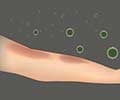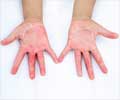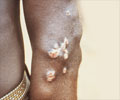Causes
The cause of a rash can be diagnosed based on the type of lesions and associated symptoms.
Some common causes of rashes are listed below:
Viral Infection: Viral infections are common causes of rashes that spread all over the body. The rash of viral infections is commonly associated with fever. Diagnosis is usually based on the pattern of appearance of the rash. Some of the features associated with common viral rashes are given below:
- The rash of chicken pox is accompanied by intense itching. It appears as small red spots or macules on the face, scalp, trunk and later the limbs. The macules then get converted into papules and vesicles. The base of the vesicles is usually reddish in color, giving an appearance of “dewdrops on a rose petal.” The vesicles may get converted into pustules, which heal by crusting.
- The rash of shingles usually appears along the course of a nerve and is accompanied by pain along the nerve.
- The rash in measles is preceded by high fever and respiratory symptoms like sneezing and sore throat. The rash appears as small papules on the face and behind the ears, which may join together to form larger lesions. The rash then spreads to the trunk and the extremities including palms and soles. It fades in the same order of appearance.
- The rash of German measles is a fine rash with macules and papules. It is accompanied by swelling of lymph nodes.
Bacterial Infection:
- Impetigo is a contagious skin disease caused by either staphylococcal or streptococcal bacteria. It commonly affects the face and other exposed parts of the body. The rash contains superficial blisters filled with pus. The blisters rupture easily resulting in crusting.
- Meningitis or inflammation of the tissues covering the brain can result in a rash that does not blanch with pressure. The presence of a rash in meningitis indicates a medical emergency. The patient also shows the presence of other symptoms of meningitis like fever, headache, stiff neck and altered mental status.
- Sexually transmitted diseases may be accompanied by a rash especially in the pubic area. The type of rash varies according to the underlying condition.
- Staphylococcal scalded skin syndrome (SSSS) results following infection with staphylococcal bacteria. The bacteria release a toxin in the blood, which causes the rash. The rash may vary from small blisters, to large blisters with separation of sheets of superficial skin resulting in erosions.
- Toxic shock syndrome (TSS) is a condition similar to staphylococcal scalded skin syndrome and involves fever and loss of sheets of superficial skin. The condition was especially observed with infection following the use of tampons. It can also follow superficial skin infections, surgical wound infections, infections following delivery, or the use of infected nasal packing. TSS is a medical emergency.
- Erythema is a skin conditions associated with redness or a skin rash. It is typically caused by an infection or allergic reaction and may range from a mild skin rash to a life-threatening emergency.
Fungal Infection:
- Ringworm is a type of fungal infection of the skin. The skin lesions are ring-shaped with an advancing scaly border and central clearing. It appears on the exposed skin surfaces like between fingers and toes, or the trunk. Itching over the lesions may be present.
- Pityriasis versicolor is a common skin condition that appears as velvety, tan, pink or white macules, usually in the face and upper trunk. Scales are not obvious over the lesions but are obtained on scraping.
Allergy: The skin is among the most common organs that mirror the symptoms of an allergic reaction. Allergic skin reactions vary from mild to severe. Reactions that appear when a person comes in contact with an allergen are called contact dermatitis. Mild allergic skin reactions include itching and rashes over a part or all over the body. Itchy swellings called hives may occur. The patient may also suffer from dry skin with raw areas from scratching. Severe reactions could involve swelling of the skin and mucus membranes. The skin may develop blisters with oozing.
Autoimmune Disease:
- Psoriasis is an autoimmune condition where skin lesions appear on the scalp, elbows, knees, lower back, and between buttocks. The skin shows the presence of plaques covered with silvery-white scales. Removal of a scale may reveal pinpoint bleeding. Itching over the lesions may be present. Variations in the type of rash are also observed.
- Some people with systemic lupus erythematosus (SLE) have a typical rash on the cheeks, which resembles a butterfly. Other features of SLE include joint and kidney disease.
Medications:
Medications could also cause skin reactions. Drugs that frequently cause allergic reactions include penicillins, cephalosporins, ACE inhibitors and rifampicin. These could cause different types of rashes usually over the whole body. A serious form of allergic skin reaction is Stevens - Johnson syndrome. Drugs like penicillins, sulfonamides, phenytoin and NSAIDs have been found to cause SJ syndrome.
Arthropod Bite:
- The rash in scabies is itchy in the form of vesicles and pustules especially in the finger and toe webs and the wrist creases. The burrows through which the scabies mite burrows into the skin may be obvious.
- Bedbug rash usually appears in the morning when the person gets up from sleep. The rash typically appears in a line and as small bumps, which are very itchy.
Other Causes of Rash:
Acne: Acne causes a rash after puberty. It usually affects the face and neck area. It consists of small swelling with a black or white head at the tip, which is sometimes filled with pus.
Heat rash: Heat rash, also called prickly heat, appears in the summer season as tiny, itchy or prickly blisters especially over the neck and trunk area. It occurs due to the blockage of the sweat pores.
Diaper rash: Diaper rash is a bright red rash observed in the diaper area of a baby. It occurs due to a fungal infection beneath the diaper.
Liver and Kidney disease: Diseases affecting the liver and kidneys are associated with rashes all over the body. The patient usually shows symptoms of the underlying conditions.
Stasis Dermatitis: Stasis dermatitis occurs due to lack of drainage of blood from the lower limbs. It results in red, itchy rash on the lower legs. The rash may be dry and scaly or may show the presence of fluid-filled vesicles and form crusts. If the condition is present over a long duration, the skin color may change to brown or purple.
Cancer: Cancers like leukemia and lymphoma can result in a rash. The rash in leukemia appears as small red spots under the skin called petechiae. Patients with lymphoma may suffer from an itchy and red skin.
















